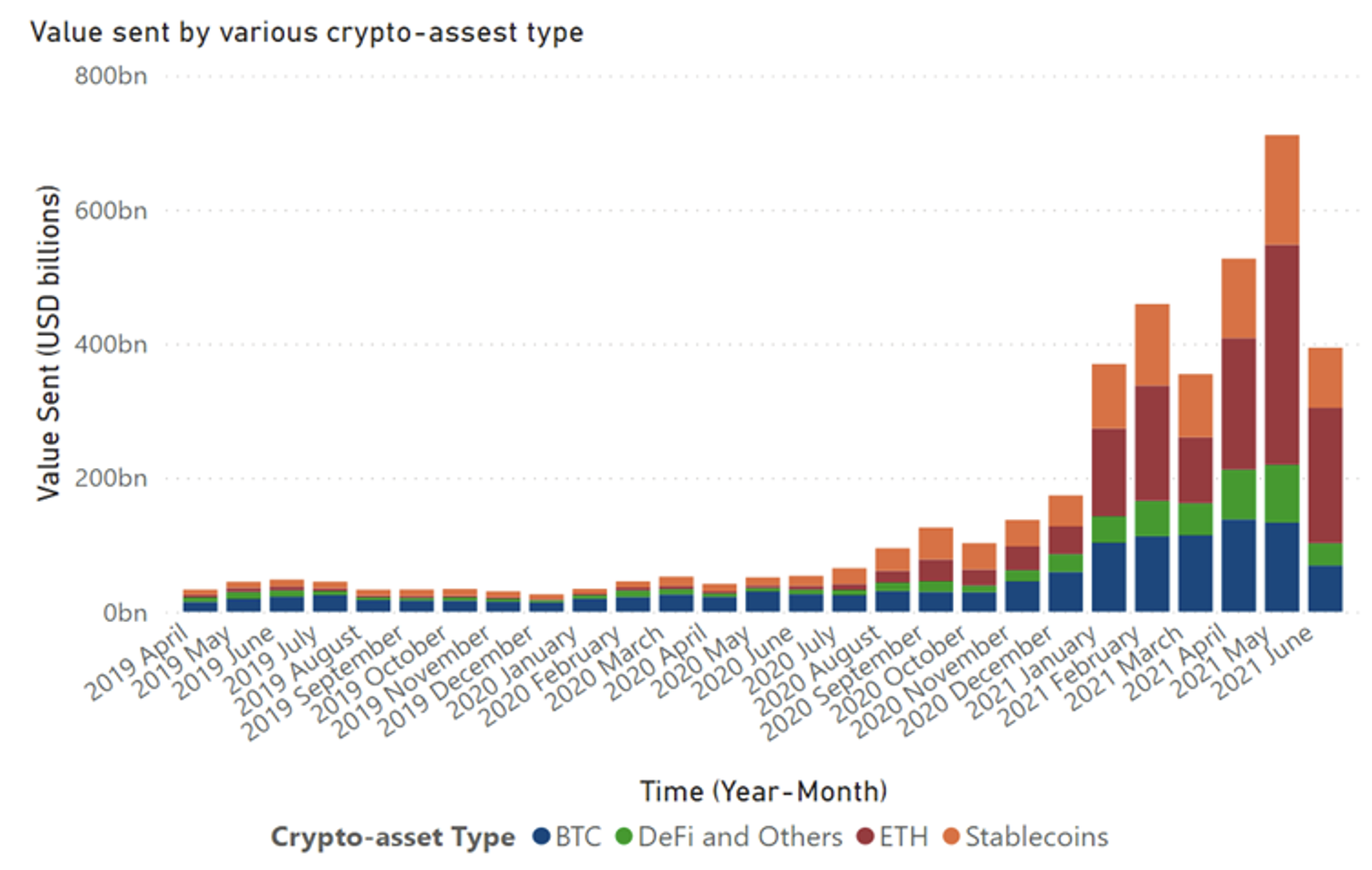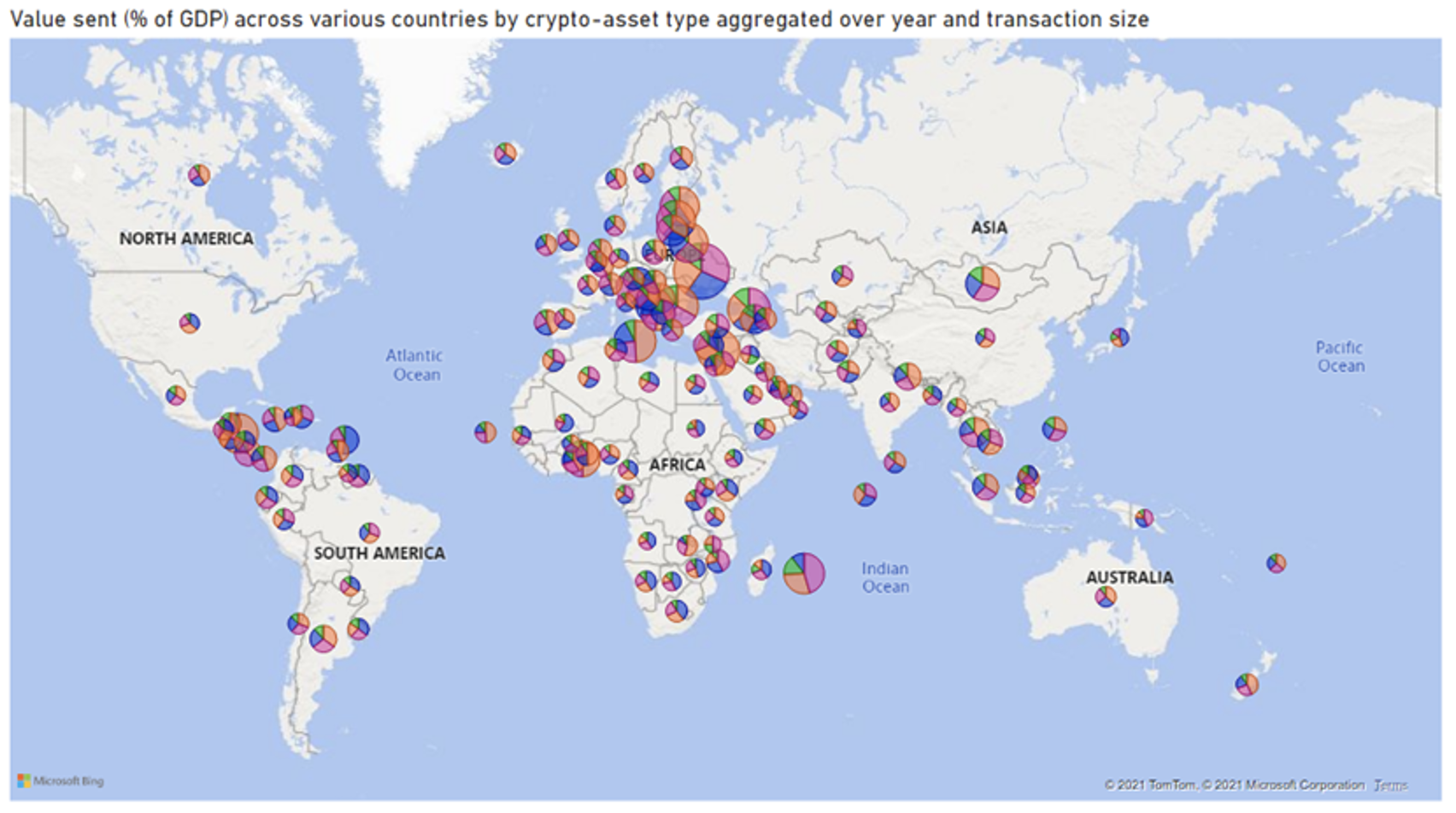
‘On-chain’1 crypto-asset transaction volumes have seen rapid growth globally driven by retail and institutional adoption, particularly since the beginning of the Covid-19 pandemic and against a backdrop of extraordinarily loose global financial conditions. The emerging crypto-asset industry is diverse and offers different potential opportunities and risks across different types of assets. While thousands of crypto assets exist, bitcoin, ether, and a small set of stablecoins represent the large majority of crypto volumes, with a relatively minor but growing role for Decentralised Finance (DeFi) – an experimental financial services ecosystem that relies on a distributed ledger or similar technology.
In light of its growing scale, diversity, complexity, and interconnectedness with the regulated financial system which may amplify risks, understanding the main drivers behind crypto-assets usage is relevant for policymakers, users, and industry alike.
While bitcoin, the original crypto asset, was conceived as a peer-to-peer electronic cash system without the need for an intermediary, crypto assets, including stablecoins, are currently not widely used as a medium of exchange, although recent research finds evidence that bitcoin has been used as a vehicle for domestic transactions and international payments (e.g. Graf von Luckner et al. 2021). Additional relevant factors for crypto-asset adoption may also include high expected returns from speculative investment (Auer and Tercero-Lucas 2021), their role as a perceived macro hedge protecting against macro-financial instability and excessive inflation despite their high volatility (Blau et al. 2021, Conlon et al. 2021), and regulatory arbitrage, particularly related to illicit activity. Given their ease of storage and portability, crypto assets may also support people “living under the threat of harm by their families, people in their communities, or repressive governments” (Peirce 2021). Regarding DeFi, Harvey et al. (2021) conclude that it has potential to overcome the inherent challenges of the traditional financial sector of centralised control, limited access, inefficiency, opacity, and lack of inter-operability.
In a new paper (Feyen et al. 2022), we document the rise in on-chain crypto-asset activity around the world at the country level – transactions that are directly recorded on the distributed ledger that underpins a crypto-asset – and empirically investigate the association of crypto-asset volumes across countries with key global and domestic macroeconomic drivers.
Rapid rise of crypto activity around the world
Although data gaps are significant (e.g. IMF 2021), it appears that crypto-asset activity is a global phenomenon. Some industry estimates claim that 100-200 million people around the world owned or use crypto assets in 2021, including in many emerging market and developing economies (EMDEs).
We use a large global monthly country panel of on-chain crypto-asset transaction volumes of value sent in US dollars provided by Chainalysis, a global blockchain analysis company, to investigate the potential drivers of crypto-asset activity in various ways. The sample spans the period April 2019 to June 2021 and covers 174 countries and 114 different crypto assets. We mapped all crypto assets into four groups: (1) Bitcoin, (2) Ethereum, (3) stablecoins,2 and (4) DeFi and others.3
Total crypto-asset on-chain volume over the past two years surged to a total of $2.8 trillion in the first half of 2021 alone. Figure 1 illustrates that the volumes in ether (40%) and stablecoins (24%) has gained more share over time compared to bitcoin (24%); DeFi and other crypto assets represent 12%. When looking at crypto activity by transaction size, we find that large value transfers ($2.68 trillion) dwarf smaller transaction size transfers ($128 billion), suggesting a disproportionately large role of institutional activity.
Figure 1 Total crypto-asset volume by asset type (in US dollars)
Sources: Chainalysis, World Bank staff calculations.
Figure 2 shows that the geographical distribution of crypto-asset activity is global. Annualised total volumes of crypto-asset activity for 2021 relative to GDP have become noticeable, particularly in regions like Latin America and the Caribbean (median: 0.07% of GDP), sub-Saharan Africa (median: 0.06% of GDP) and Europe and Central Asia (median: 0.10% of GDP). Activity is relatively limited in lower- and middle-income countries and is dominated by bitcoin and ether. Smaller transactions still represent a minor fraction (10%) of total volumes across countries. The share of stablecoins also remains relatively low with 16% of the overall volume.
Figure 2 Total crypto-assets volume by asset type(April 2019-June 2021)

Source: Chainalysis, World Bank staff calculations.
Note: A map of crypto-assets activity scaled by a country’s GDP – larger bubbles indicate higher activity relative to the size of the economy. The bubble sizes representing the relative values sent (% of GDP).
The data also suggest that the majority of the volume is concentrated in North America (the US in particular) and Europe and Central Asia, with these two regions combined representing 56% of overall activity aggregated over our full sample period. While developed and high-income economies continue to represent a larger share of the overall crypto activity in absolute value of transfers across all transaction sizes, the share of activity in regions like East Asia Pacific, Latin America and the Caribbean, South Asia, and Sub-Saharan Africa is gaining momentum.
Macro-financial drivers of crypto-asset activity
The empirical findings suggest that crypto-asset volumes are strongly associated with a set of forward-looking global macro-financial factors – which may ultimately shape domestic macro-financial conditions – rather than recent domestic macroeconomic developments. For example, controlling for a range of global and domestic factors, a ten basis-point increase in monthly US inflation expectations (on a five-year, five-year forward basis as embedded in US Treasury yields) increases monthly crypto volumes by about 28 basis points. In contrast, country-level macroeconomic indicators (e.g. inflation and the exchange rate) do not appear to be strongly related with country-level volumes.
Country-level volumes also move in the opposite direction to gold prices, suggesting that crypto assets are seen to some extent as a substitute for gold – a traditional global inflation hedge. The results further imply that crypto assets are perceived as a speculative ‘risk-on’ asset class, with higher volumes when real US Treasury yields – a proxy for global financial conditions – are lower. Crypto volumes also appear to be supported by a momentum effect in crypto-asset prices further suggesting that speculative motives play a role.
We also find some tentative evidence that crypto activity is higher in countries with higher information and communications technology (ICT) penetration and broadband subscriptions per capita. This offers some support for the idea that crypto assets may address some of the challenges associated with cross-border payments, which can be slow and costly, but further research is necessary to substantiate this. Nascent implementations of new technologies (e.g. the Lightning Network; see Poon and Dryja 2016) that could address current transaction throughput challenges of crypto assets may help accelerate adoption for (cross-border) payment transactions, but these technologies are largely untested at scale and may also pose new risks.
Conclusion
Crypto assets are increasingly regarded as an emerging and diverse asset class as economic functions and risks differ across crypto assets (e.g. unbacked crypto assets, stablecoins, and Decentralised Finance).
While not a panacea to overcome financial sector challenges, crypto assets and the underlying technology hold promise for financial innovation, inclusion, efficiency, transparency, and capital formation. However, in view of their decentralised and cross-border nature, which poses international regulatory arbitrage challenges, crypto-assets also present several serious risks, including to financial integrity, consumer and investor protection, fair competition, monetary sovereignty, capital control enforcement, and taxation (e.g. FATF 2021, BCBS 2020, G7 2019). Further, while crypto assets still constitute a small portion of the global financial system, they could ultimately pose risks to global financial stability (e.g. FSB 2022).
Our findings shine new light on the rapid growth and diverse drivers behind crypto-asset activity and offer support to the notions that crypto assets are perceived as a risk asset, a potential longer-term macro hedge, and a potential tool to support cross-border payments. However, our results should be interpreted with caution: a significant portion of the sample period includes extraordinary loose global financial conditions; the crypto volume data have a short history, rely on important limiting assumptions, and do not represent all crypto activity; and crypto-assets represent a fast-evolving, increasingly diverse asset class and industry.
References
Auer, R and D Tercero-Lucas (2021), “Distrust versus speculation? The drivers of cryptocurrency investments”, VoxEU.org, 6 October 2021
Basel Committee on Banking Supervision (BCBS) (2021), “Consultative Document: Prudential Treatment of Cryptoasset Exposures”.
Blau, B, T Griffith and R Whitby (2021), “Inflation and Bitcoin: A Descriptive Time-Series Analysis”, Economics Letters 203.
Conlon, T, S Corbet and R McGee (2021), “Inflation and cryptocurrencies revisited: A Time-scale Analysis”, Economics Letters 206.
Feyen, E, Y Kawashima and R Mittal (2022), “Crypto-assets activity around the world: Evolution and macro-financial drivers”, World Bank Working Paper.
Financial Action Task Force (FATF) (2021), “Updated Guidance for a Risk-Based Approach to Virtual Assets and Virtual Asset Service Providers”.
Financial Stability Board (FSB) (2022), “Assessment of Risks to Financial Stability from Crypto-assets”.
G7 Working Group on Stablecoins (2019), “Investigating the Impact of Global Stablecoins”.
Graf von Luckner, C, C Reinhart and K Rogoff (2021), “Decrypting New Age International Capital Flows”, NBER Working Paper 29337.
Harvey, C R, A Ramachandran and J Santoro (2021), DeFi and the Future of Finance, John Wiley & Sons.
International Monetary Fund (IMF) (2021), “The Crypto Ecosystem and Financial Stability Challenges”, Chapter 2 in Global Financial Stability Report.
Peirce, H (2021), “Paper, Plastic, Peer-to-Peer”, U.S. SEC Commissioner Remarks at the British Blockchain Association’s Conference “Success Through Synergy: Next generation Leadership for Extraordinary Times”.
Poon, J and T Dryja (2016), “The Bitcoin Lightning Network: Scalable Off-Chain Instant Payments”, Digital Currency Initiative paper, MIT Media Lab.
Endnotes
1 Not all crypto-assets transactions are ‘on chain’. ‘Off-chain’ transactions are only recorded on centralised ledgers and private order books of intermediaries such as crypto-assets exchanges, custodial wallets, and financial institutions. These ‘off-chain’ transactions may involve buying or selling of crypto-assets in exchange for fiat currency or exchanging one crypto-asset for another.
2 The stablecoin category in our analysis include some of the major US dollar-linked stablecoins: USD Coin (USDC), Tether (USDT), DAI (crypto-assets backed), TrueUSD (TUSD), Paxos USD (Dollar (PAX), Binance USD (BUSD), and Gemini Dollar (GUSD). In November 2021, the top three stablecoins accounted for about 85% of the total stablecoin market capitalisation.
3 The ‘DeFi and Others’ category includes 103 different crypto assets. The top ten with the largest volume are: Wrapped Ether (WETH), XRP, Litecoin (LTC), Wrapped Bitcoin (WBTC), Chainlink (LINK), Bitcoin Cash (BCH), EOS, Uniswap (UNI), Yearn Finance (YFI), and Sushiswap (SUSHI).
This news is republished from another source. You can check the original article here



